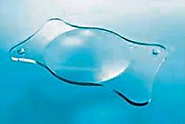

HAPTICS
Side structures, which hold the IOL in place within the capsular bag
LOOP HAPTIC DESIGN
Current IOLs can exist as 3-piece or 1-piece (single-piece), where the haptic insertions differ.
3-PIECE IOLS
-
Create a ‘C’ shape, thus are known as C-loop IOLs
-
Insert into the optic edge through two holes.
-
This IOL enables the round capsular bag shape to be retained
-
The loops occur at an angle of around 5-10º, preventing pigment dispersion
via iris disruption
-
Used less, but are useful for when posterior capsule rupture occurs and are required for implanting to the sulcus
-
C-loops require large corneal incisions
-
The loops produced are large and unmanageable, hence cannot be injected during surgery
1-PIECE
-
Single-piece IOLs have a slightly shorter structure compared to that of a 3-piece IOL
-
They have C-loops made for both capsular and ciliary sulcus insertion
-
Modified C-loop with either 2, 3, 4 or 6 haptics in order to counteract posterior pressure and capsular bag contraction without dislocation of the IOL.
PLATE HAPTIC DESIGN
-
Used for toric IOLs due to their capability of clockwise and anticlockwise rotation
-
These lenses, via capsular bag contraction, are inserted into the vitreous chamber
-
Squeezing action is made easier due to the silicone material that they are made of
HAPTIC MATERIALS
-
In order for a haptic to effectively carry out its function, its design needs to be of an increased strength and flexibility
-
Originally, polypropylene met these requirements and was used as a material to construct haptics.
-
However, later it was found to degrade inside the eye and was no longer used.
-
-
PMMA (polymethyl methacrylate) is a material used in developing countries due to its low cost, however is known to be fragile unless compression moulding is implemented.
-
There have been cases where the haptics become bent during implantation along with decentring
-
-
A chemical compound known as PVDF has shown to have good retentive memory, flexibility and adhesion to the capsule compared to PMMA.
-
However, despite this materials strength and stability, once attached, removal is virtually impossible
-
-
Another common material used for haptics is Polyamide, a flexible material which is tolerant to degradation in the eye when positioned behind the iris


Click below to find out more...